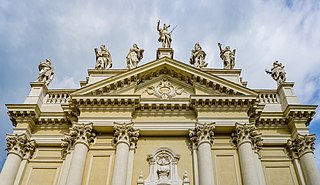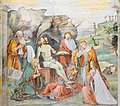
Belisario Corenzio was a Greek-Italian painter, active in Venice and Naples. He is one of few Greek painters that did not belong to the Cretan Renaissance like his contemporaries of the time. He escaped the maniera greca completely. He adopted the Venetian style. Other similar Greek painters were Marco Basaiti, Ioannis Permeniates, Antonio Vassilacchi and El Greco. He was sometimes referred to as Il Greco. His teacher was prominent Venetian painter Tintoretto. In 1590, at age 32 Corenzio settled in Naples. Corenzio was influenced by Cavalier d'Arpino. He continued to flourish in the region. His apprentices included: Luigi Rodriguez, Andrea di Leone, Onofrio De Lione and Massimo Stanzione. Corenzio painted many frescos that survived today. Some of his works are in the Church of San Severino and Certosa di San Martino. His style resembles Caravaggio. An Italian legend in Naples exists involving Corenzio, Spanish painter Jusepe de Ribera, and Battistello Caracciolo. They were referred to as the Cabal of Naples. The three painters were rumored to have poisoned their competition for painting contracts. The rumors lack documented evidence. The three painters were very popular in Naples. Corenzio frescoed the Crypt that holds the remains of Matthew the Apostle at Salerno Cathedral and it depicts scenes from the Gospel of Matthew. Corenzio was one of the most celebrated fresco painters in Naples during his time. His drawings can be found all over the world namely at the Metropolitan Museum, Museo di Capodimonte and Louvre.

Alessandro Bonvicino, more commonly known as Moretto, or in Italian Il Moretto da Brescia, was an Italian Renaissance painter from Brescia, where he also mostly worked. His dated works span the period from 1524 to 1554, but he was already described as a master in 1516. He was mainly a painter of altarpieces that tend towards sedateness, mostly for churches in and around Brescia, but also in Bergamo, Milan, Verona and Asola; many remain in the churches they were painted for. Most are on canvas, but a number even of large ones are on wood panel. Only a handful of drawings survive.

Vincenzo Foppa was an Italian painter from the Renaissance period. While few of his works survive, he was an esteemed and influential painter during his time and is considered the preeminent leader of the Early Lombard School. He spent his career working for the Sforza family, Dukes of Milan, in Pavia, as well as various other patrons throughout Lombardy and Liguria. He lived and worked in his native Brescia during his later years.

Alessandro Maganza (1556–1630) was an Italian painter of the Mannerist style, born and active in Vicenza, as well as in Venice.

Antonio d'Enrico, called Tanzio da Varallo, or simply il Tanzio was an Italian painter of the late-Mannerist or early Baroque period.
Events from the year 1522 in art.

Bastiano di Bartolo Mainardi was an Italian painter of the Early Renaissance. He was born in San Gimignano and was active there and in Florence.

The Averoldi Polyptych, also known as the Averoldi Altarpiece, is a painting by the Italian Renaissance painter Titian, dating to 1520–1522, in the basilica church of Santi Nazaro e Celso in Brescia, northern Italy.

The church of Santi Nazaro e Celso is located on Corso Giacomo Matteotti, at the intersection with via Fratelli Bronzetti, in Brescia, Lombardy, Italy. The church contains the Averoldi Polyptych (1522), a masterwork of Titian.

Sante Cattaneo or Santo Cattaneo was an Italian painter of the Neoclassic period, mainly active in Brescia.

Santi Nazaro e Celso is a Romanesque-style, Roman Catholic church on the street that leads to the Porta Vescovo, in the Veronetta quartiere of Verona.

Francesco Podesti was an Italian painter, active in a Romantic style. Together with Francesco Hayez and Giuseppe Bezzuoli, he is considered one of the greatest Italian painters of the first half of the 19th century. He was prolific in his large canvases on historical subjects. He is best known for his fresco work, including those in the Hall of the Immacolata in the Vatican Museum.
Antonio Ridolfi (1824–1900) was an Italian painter noted for his paintings of sacred and historical subjects, as well as costume genre pieces.

Brescia is a city and comune in the region of Lombardy, Northern Italy. It is situated at the foot of the Alps, a few kilometers from the lakes Garda and Iseo. With a population of more than 200,000, it is the second largest city in the administrative region and the fourth largest in northwest Italy. The urban area of Brescia extends beyond the administrative city limits and has a population of 672,822, while over 1.5 million people live in its metropolitan area. The city is the administrative capital of the Province of Brescia, one of the largest in Italy, with over 1,200,000 inhabitants.
Bartolomeo Caylina was a 15th-century Italian painter active mainly in Lombardy in an early-Renaissance style.

Gaetano Capone was an Italian painter, mostly depicting landscapes and genre subjects.
Madonna and Child with St Peter and St Paul is a c.1515 painting by Perugino or his studio, held in the Collegiata dei santi San Pietro e Paolo in Monteleone d'Orvieto. It shows the Madonna and Child between St Peter and Paul of Tarsus, with a semi-circular cimasium showing the Resurrection.

Adoration of the Shepherds with Saints Nazarius and Celsus is a 1540 oil on canvas painting by Moretto da Brescia in the church of Santi Nazaro e Celso in Brescia. As its title suggests, it shows Nazarius and Celsus, patron saints of the church.

The Assassination of Saint Peter Martyr or The Martyrdom of Saint Peter of Verona is a 1530–1535 oil on canvas painting by Moretto da Brescia, now in the Sala dell'Esedra in the Pinacoteca Ambrosiana in Milan.

Andrea Carrera or Carreca was an Italian Baroque painter mainly active in Sicily. He was born in Trapani and died in Palermo.





















